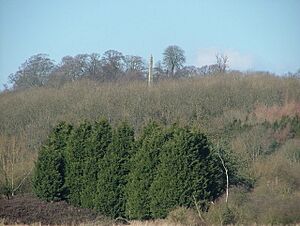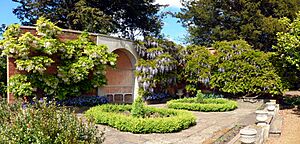Farnborough Hall facts for kids
Farnborough Hall is a beautiful old country house located in Warwickshire, England, close to the town of Banbury. It's a very special place because it has been looked after by the National Trust since 1960. The Holbech family, who have lived there for a long time, still help manage the house and its amazing gardens. Farnborough Hall is considered a Grade I listed building, which means it's a very important historical site.
Contents
History of Farnborough Hall
Early Owners and Changes
The Farnborough estate was bought by Ambrose Holbech in 1684. Before that, the Ralegh family had owned the land since the 1200s! Experts have found that the Raleghs actually moved the house from its original spot in the 1600s. The new house was built using strong Hornton stone from the Cotswolds.
Even though Ambrose Holbech bought the property, it was his son, William, who started making big changes. He began renovating the house after he married Elizabeth Arlington in 1692.
The Grand Tour and Art
William Holbech inherited the estate. After he returned from a "Grand Tour" in the 1730s, he wanted to make the house perfect for showing off his new treasures. A Grand Tour was a long trip around Europe that young, wealthy people used to take to learn about art and culture. William brought back many amazing things, including pottery, sculptures, and paintings by famous artists like Canaletto and Giovanni Paolo Panini.
The inside of the house has incredible plasterwork done by an artist named William Perritt. Around 1745–1750, the hall was redesigned in the Palladian style. This style was very popular and was perhaps designed by Sanderson Miller. We know a lot about this time from a book written by Reverend George Miller in 1900.
Wartime Use and National Trust
In 1771, another William Holbech took over the estate. The National Trust has been working to restore the parkland to how it looked in 1772. Later, from 1815 to 1816, another Holbech asked Henry Hakewill to build a new coach-house. He also redesigned the rose garden and a path leading to a waterfall, which is now called 'Granny's Walk'.
During the First World War, Farnborough Hall was used as a hospital. It was known as Farnborough Auxiliary Hospital. After the war, some of the original paintings by Canaletto and Panini were sold.
The house was also used as a military hospital during the Second World War.
In 1960, Geoffrey Holbech gave the house and estate to the National Trust. He inherited it from his older brother after the Second World War. Even today, in 2025, the Holbech family still lives in the hall. They help the National Trust welcome visitors during certain times of the year.
Exploring the Gardens and Parkland
Unique Garden Style
The parkland at Farnborough Hall is very special. It's a rare example of a "ferme ornée" (pronounced "ferm or-nay") style of landscaping. This means it was designed to be both beautiful and practical for farming. Farm buildings looked pretty but still worked well, fitting into the lovely scenery. Sanderson Miller, a garden designer like the famous Capability Brown, redesigned the parkland for William Holbech II.
Amazing Views and Structures
One of the most important parts of the garden is the Terrace Walk. It was built on a natural slope and has 26 different spots where you can stop and enjoy the view! This walk is 1200 meters long.
Near the house, you'll find the Game Larder, which looks out over St Botolph's Church. As you walk along the Terrace, you'll see the Ionic Temple and the Oval Pavilion. At the very end of the walk is the Obelisk, a tall stone pillar that is 18 meters high. It overlooks the Warmington Valley. The Obelisk was first mentioned by a visitor in 1746. It fell down in 1823 but was rebuilt in 1828. You can still see names etched into its base, including one from an Italian prisoner of war during the Second World War. The Terrace also had a waterfall, which was repaired in 2016. There was even a Georgian amphitheatre in the park!
Water Features
Miller also made the parkland look more natural. He created a winding pond called the Serpentine, which was designed to look like a flowing river. This pond was repaired in 2015. Miller also raised part of the River Sor by 5 meters to create a beautiful ornamental pool. This pool, known as the Oval Pond, could be seen from the house. It had dried out, but its shape could still be seen in the ground in 2016. Above it was Sourland Pond, built on land that was already wet.
Trees and Plants
Miller used trees like Scots pines to highlight different parts of the landscape, both near and far from the house. Also, between 1786 and 1790, Mrs. William Holbech received several Cedar of Lebanon trees from her great-grandson, Lord Warwick, for the estate.
The gardens also have the remains of an orangery (a special greenhouse for orange trees) and a lovely rose garden.
Why Farnborough Hall is Special
The estate and gardens at Farnborough are important for a few reasons. They are a great example of the "ferme ornée" style of landscaping, which is quite rare. They also show an important step in how English landscape gardens developed in the early 1700s.
Farnborough Hall is a Grade I listed building, meaning it's a very important part of England's history and heritage.
Gallery








